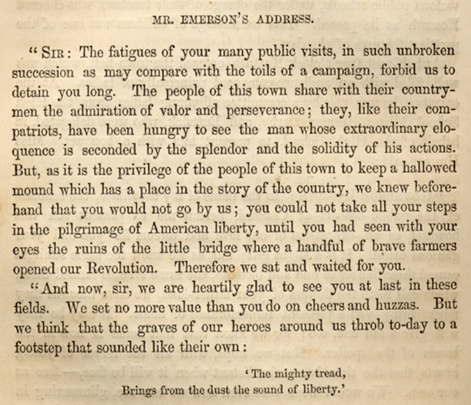40 (above) and 41 (below)
 - - ![Kossuth at Concord! Friday, May 7th, at 2 o'clock, P.M. ... Town Hall ... [printed broadside], 1852](/uploads/scollect/Emerson_Celebration/Em_Con_41_150dpi_540Wpix.jpg)
|
KOSSUTH IN CONCORD,
1852
40. Ralph Waldo Emerson. “Mr. Emerson’s Address,” pages 222-224 of Kossuth in New England: A Full Account of the Hungarian Governor’s Visit to Massachusetts … (Boston: John P. Jewett & Co., 1852). Letterpress on paper; bound in brown cloth. Myerson D21. From the collection of the Concord Town Library. 41. Kossuth at Concord! Friday, May 7th, at 2 o’clock,
P.M. … Town Hall … [printed broadside], 1852. Letterpress on
paper.
The plight of European political refugees following failed revolutions against autocratic rule in the late 1840s engaged the sympathy of American reformers. Margaret Fuller, who witnessed first-hand and aided the revolution in Rome, was working on a book about it when she died in 1850. Elizabeth Peabody edited a collection titled Crimes of the House of Austria Against Mankind, which was published in 1850. In 1851, exiled Hungarian statesman and patriot Lajos Kossuth traveled to America in search of assistance for his homeland. In May of 1852, Concord was one of the towns he visited in New England. Kossuth came on May 7th. He dined and visited the Battle Ground and the site of the old North Bridge—icons of the struggle for American political freedom—before proceeding to the Town Hall. The children of the town had been gathered to welcome him. Emerson formally greeted and introduced Kossuth, referring to him as “the foremost soldier of freedom in this age.”
No image in this online display may be reproduced in any form, including electronic, without permission from the Curator of Special Collections of the Concord Free Public Library.
Next Entry - Previous Entry - Back to Section V Contents Listing - Back to Exhibition Introduction - Back to Exhibition Table of Contents |